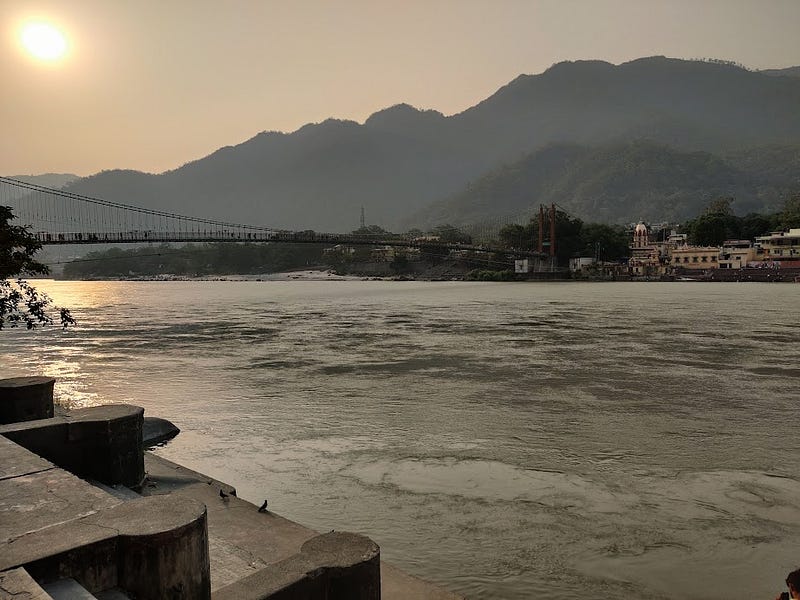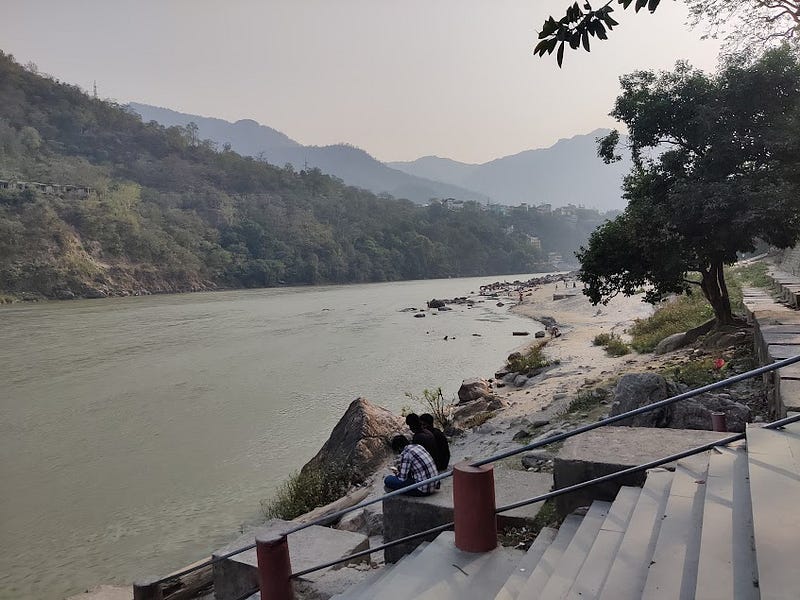
We had the chance to visit Rishikesh, a land of ancient temples, ashrams, and sacred ghats just before the G20 Summit here. A ghat is simply a place where pilgrims gather to perform religious rituals and seek blessings on the Ganges River. The city was almost ready for the influx of delegates. Beautiful hoardings of the culture, traditions and people connected one to a captivating experience. A few last-minute touches like the whitewashing of the manmade rocky walls set as tiny barricades at certain spots were being painted. We saw a few more pictures and deep cleaning being done enthusiastically.
Rishikesh in India is known as the World Yoga Centre and is famous for the rigorous penance that was taken up here, it is also the start of the four main pilgrim spots in North India, Char Dham consisting of Yamunotri, Gangotri, Kedarnath and Badrinath. It is a great adventurous place with Kayaking and Himalayan treks. We found the place bustling with people just as any other spiritual place. It’s a small city and one can walk down to any other place yet there were many cabs that had travelled from various places to this parking on the Ganges where our cab driver was trying to park the car. The cab driver displayed great expertise as he squeezed the car into the parking. A young-looking man in jeans and a white T-shirt who was our guide hurriedly took us away to a spot where we were to buy tickets to board a ferry. He also started telling the whole mythology from the division of eras called Yugas. He said this era is the shortest, and even before I could respond he said, ‘Come fast, we need to stand on the Quay before the other passengers arrive’.
The Quay was a rickety one with gaps in between. The sudden shift from a cab to a quay was a little tricky as I feared a boat ride more than ever. I asked him, ‘How deep is the water? He said ‘It is around 15–20 feet in the centre and lesser on the sides but the Ganges never dries’. I felt this era definitely seemed short. Any mishap and my soul would fall at Lord Vishnu’s feet. As the boat came near the quay, our guide Arjun Singh jumped in and showed us our seats. He tried telling us some more details but each time he would begin, his voice would get drowned in the voices of the people. The boat was full within seconds and took off to drop us on the opposite bank called the Parmarth Niketan Ghat. Arjun Singh jumped off first and directed our steps towards the ghat. He hurriedly took us to a series of temples, a Ram Temple, a temple of Shiva, an old ancient temple. He took us to Gita Bhavan and the wall where 700 shlokas were written on a single page. He then showed us the Rudraksha plant that bears a kind of stonefruit whose faces are multifaceted. Rudraksha seeds are used as holy beads for prayers. Just as we finished understanding and wondered what next, Arjun Singh said, ‘Now you will wash your hands and visit a shop and maybe buy what you need’. I said, ‘What do I need? After leaving the temple, we saw two old lady beggars sitting comfortably and talking to each other. Another old man was sleeping uncomfortably in the noise and din. They weren’t begging but knew that people like us would give them something to atone for our sins. I gave some money to the ladies and then tried to wake the man up. The lady said ‘I will give it to him, he is resting’. There were numerous people praying, many others begging on the way. We were led to a Govt shop where gems and beads were sold after washing our hands in a wayside place. The shop had huge wooden doors and was cool inside with an air conditioner. We were shown sphatik and other crystals. A sphatik crystal calms the mind, gives concentration, and cools the body. The govt shop showed a lab-tested report for each item. The things were expensive but we bought some of them.
We checked into our hotel close to the Ganges. We set out for Ganga Aarti in the evening on the Triveni Ghat which was a few kilometres away. The road to the ghat was filled with vehicles and the traffic slowed down numerous times. Triveni Ghat is the confluence of three main rivers — the Ganga, the Yamuna and the Saraswati where the Ganga arti is performed to the chants of Vedic hymns. These shores are accessible by foot after parking on the highway and walking through the lanes. It took us just a few minutes to reach the place filled with people. A few children were selling flowers arranged in a circular manner with an oil lamp and a matchbox for ten rupees each. We bought one and made our way through the crowd to reach the confluence to light the lamp and sail the leafy plate with flowers and lamp with the tide. The Ganges came alive with the sight of oil leaves, filled with petals, released by devotees. The Ganga aarti was an enchanting one done by the students learning the scriptures with the Vedic hymns and chants. There was a rhythmic beat as the mob prayed on the shore along with the marigold garlands and flowers floating on the Ganges that made everything spectacular.

The next morning began with the Chants of Krishna in the lane by the Hare Krishna followers. It led people to follow the saffron-clad devotees chanting the Hare Krishna mantra. We welcomed the start and walked to the Ganga Ghat to witness the calm, steady and resplendent flow of the Ganges. The water was cool and the people very few. There was peace and no noise in the air. A little away sat a spiritual guru who read the scriptures written on a short papyrus scroll. He would read a shloka and look around in the serenity of the morning peace. A monkey sat right in front of him eating something from a packet given by the saint. The monkey made no noise in its chomping, the saint did not read the verses aloud for it was just silence that mattered and nothing else. We sat for a long and felt we would cross the river on the huge Ram Jhula. There were people moving that morning but there was no accompanying sound. A vendor carrying a huge loud was helped to roll his cart on the bridge, an old lady was smiled at and given her morning tea in an earthenware cup by philanthropists but it all happened in the backdrop of silence. We reached the opposite bank to buy tea sold near the ghat. There sat an old man in anticipation of tea and money. The sunshine was a bit harsh but he sat peacefully saying it was well-needed for his ageing bones. He relished his cup of tea and we carried our tea close to the Ganges. We drifted along the Ganges into the picturesque hills, covered with lush vegetation that provided a breathtaking backdrop to the tranquil waters. The soft rustling of leaves and the occasional chirping of birds added to the harmony of nature, immersing us in the beauty of the surroundings. The Ganges flowed silently, serenely, and steadily as if it personified peace as we sat there watching it
Comments
Post a Comment